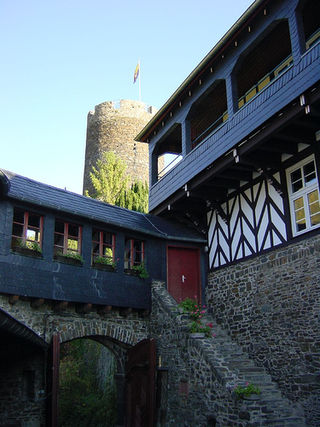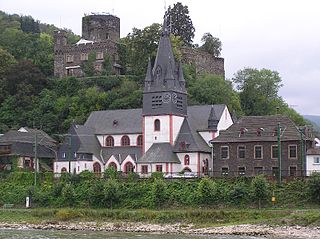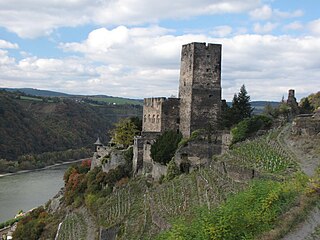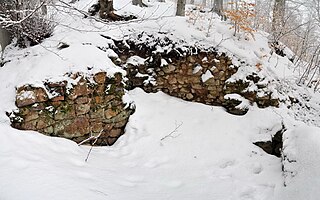
Bacharach is a town in the Mainz-Bingen district in Rhineland-Palatinate, Germany. It belongs to the Verbandsgemeinde of Rhein-Nahe, whose seat is in Bingen am Rhein, although that town is not within its bounds.

The Rhine Gorge is a popular name for the Upper Middle Rhine Valley, a 65 km section of the Rhine between Koblenz and Rüdesheim in the states of Rhineland-Palatinate and Hesse in Germany. It was added to the UNESCO list of World Heritage Sites in June 2002 because of its beauty as a cultural landscape, its importance as a route of transport across Europe, and the unique adaptations of the buildings and terraces to the steep slopes of the gorge.

Sankt Goar is a town on the west bank of the Middle Rhine in the Rhein-Hunsrück-Kreis (district) in Rhineland-Palatinate, Germany. It belongs to the Verbandsgemeinde Hunsrück-Mittelrhein, whose seat is in Emmelshausen.

Sankt Goarshausen is a town located in the Rhein-Lahn-Kreis in Nassau on the eastern shore of the Rhine, in the section known as the Rhine Gorge, directly across the river from Sankt Goar, in the German state Rhineland-Palatinate. It is located within the Nassau Nature Park and the Rhine Gorge UNESCO world heritage site, and was historically part of the Duchy of Nassau. It lies approximately 30 km south of Koblenz, and it is above all famous for the Lorelei rock nearby. Sankt Goarshausen is the seat of the Loreley collective municipality. The town's economy is based on wine making and tourism.
The Rheinsteig is a hiking trail following a mainly elevated path along the east bank of the Rhine River in Germany. Its 320 kilometres (200 mi) route stretches from Bonn to Wiesbaden, running parallel to the Rheinhöhenweg Trail and Rheinburgenweg Trail.

Pfalzgrafenstein Castle is a toll castle situated on Falkenau island in the Rhine River, adjacent to Kaub, Germany. Also known as "the Pfalz", Pfalzgrafenstein Castle has never been destroyed since being established in 1326/27.

Bischofstein Castle is a castle by the Moselle in Germany. It sits between Moselkern and Hatzenport; these and the castle face the borough of Burgen. It was a stronghold belonging to the Archbishops of Treves.

The Grafen von Falkenstein was a dynasty of German nobility descending from the Ministeriales of Bolanden, who held land and a castle at Falkenstein in the Palatinate region.

Niederheimbach is an Ortsgemeinde – a municipality belonging to a Verbandsgemeinde, a kind of collective municipality – in the Mainz-Bingen district in Rhineland-Palatinate, Germany.

Oberdiebach is an Ortsgemeinde – a municipality belonging to a Verbandsgemeinde, a kind of collective municipality – in the Mainz-Bingen district in Rhineland-Palatinate, Germany.

Trechtingshausen is an Ortsgemeinde – a municipality belonging to a Verbandsgemeinde, a kind of collective municipality – in the Mainz-Bingen district in Rhineland-Palatinate, Germany.

Ehrenfels Castle is a ruined hillside castle above the Rhine Gorge near the town of Rüdesheim am Rhein in Hesse, Germany. It is located on the steep eastern bank of the river amid extended vineyards. The grape variety Ehrenfelser is named after the castle.

Gutenfels Castle, also known as Caub Castle, is a castle 110m above the town of Kaub in Rhineland-Palatinate, Germany.

Liebenstein Castle is a castle above the village of Kamp-Bornhofen in Rhineland-Palatinate, Germany.

The Rhine romanticism was the interpretation of the landscape conditions and history of the Rhine Valley in the cultural-historical period of the romanticism, by the end of the 18th century until the late 19th century and was continued in all forms of art expression.

Landgrave Ernest of Hesse-Rheinfels-Rotenburg was from 1649 to 1658 Landgrave of Hesse-Rheinfels and from 1658 until his death Landgrave of Hesse-Rheinfels-Rotenburg. Because his brothers died young, all later Landgraves in the Rotenburg Quarter are descendants of Ernest. Hence, Ernest is known as the ancestor of the Catholic Rotenburg Quarter, a group of junior lines of the House of Hesse.

Hohenfels Castle is a ruined hill castle at a height of 545 m above sea level (NHN), in the Beutelfels Nature Reserve north of the village of Imsbach in the county of Donnersbergkreis in the German state of Rhineland-Palatinate. The castle may be reached via a steep footpath from the visitor mine of Weiße Grube in the valley of Langental. The path passes the "Iron Man" monument.

New Bolanden Castle is a ruined spur castle and, today, a cultural monument. It stands at a height of 260 m on the 276-metre-high Schlossberg hill immediately east of the village of Bolanden in the county of Donnersbergkreis in the German state of Rhineland-Palatinate.

Tannenfels Castle is a ruined hill castle of the motte and bailey type which stands at a height of 460 m above sea level (NN) above the village of Dannenfels on the Donnersberg hill in the county of Donnersbergkreis in the German state of Rhineland-Palatinate.
This page is based on this
Wikipedia article Text is available under the
CC BY-SA 4.0 license; additional terms may apply.
Images, videos and audio are available under their respective licenses.



















